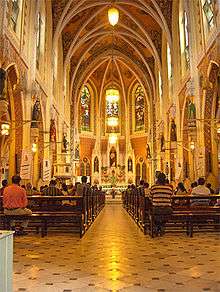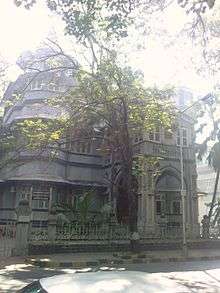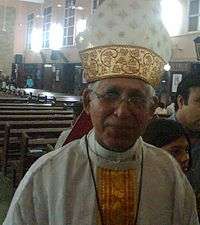Roman Catholic Archdiocese of Bombay
| Archdiocese of Bombay Archidioecesis Bombayensis मुंबई के सूबा | |
|---|---|
 | |
| Location | |
| Country | India |
| Territory | Maharashtra |
| Ecclesiastical province | Bombay |
| Metropolitan | Bombay |
| Coordinates | 18°55′24″N 72°49′50″E / 18.923457°N 72.830646°ECoordinates: 18°55′24″N 72°49′50″E / 18.923457°N 72.830646°E |
| Statistics | |
| Area | 10,103 km2 (3,901 sq mi) |
| Population - Total - Catholics |
(as of 2012) 20,399,000 525,017 (2,6%) |
| Parishes | 122 |
| Information | |
| Denomination | Roman Catholic |
| Rite | Latin Rite |
| Established | 1 September 1886 |
| Cathedral | Cathedral of the Holy Name, Mumbai |
| Patron saint | St Gonsalo Garcia |
| Current leadership | |
| Pope | Francis |
| Archbishop | Oswald Gracias |
| Auxiliary Bishops |
Dominic Savio Fernandes John Rodrigues |
| Emeritus Bishops |
Percival Joseph Fernandez Bosco Penha Agnelo Rufino Gracias |
| Website | |
| archdioceseofbombay.org | |

The Roman Catholic Archdiocese of Bombay (or Mumbai) is a Latin particular church of the Roman Catholic Church in central India's state of Maharashtra. The archdiocese has been a Metropolitan see since its elevation by Pope Leo XIII on 1 September 1886.
Its cathedral episcopal see is the Cathedral of the Holy Name, in Bombay (Mumbai). It also has a Minor Basilica of Our Lady of the Mount (Mount Mary Church), in Bandra.
As of 2006, the archdiocese had 277 diocesan priests, 283 religious priests, 383 male religious orders and 1,530 female religious orders. The archdiocese serves a total of 506,976 Catholics in 121 parishes scattered across the Mumbai Metropolitan Region (formerly Bombay).
The current archbishop is Oswald Gracias, who was appointed on 14 October 2006 by Pope Benedict XVI.[1]
History
The Portuguese first reached the west coast of India when Vasco da Gama landed at Calicut in 1498.[2] They finally established themselves at Goa in 1510.[3] In 1526, they established a factory in Bassein. In 1534, the islands of Bassein, Salsette, Bombay and Karanja were ceded to the Portuguese by Bahadur Shah of Gujarat.[4][5] In this very year, the Archdiocese of Goa was created and the whole of the western coast around Bombay formed part of that archdiocese.[6] Missionary activities in Bassein (Burma), Salsette and Bombay commenced from 1534 onwards, thus laying the foundation of the future Archdiocese of Bombay. The Portuguese missionaries who accompanied the conquerors were the Franciscans, Jesuits, Dominicans and Augustinians.
In 1637, the Holy See established the Apostolic Vicariate of Idalcan, also called Bijapur or Deccan, on vast territory split off from the Metropolitan Roman Catholic Archdiocese of Goa.
In 1665, the Bombay Island was ceded to the British as a part of the marriage dowry to Charles II of England by Catherine of Braganza of Portugal.[7] In 1669 the pre-diocesan jurisdiction was renamed as Apostolic Vicariate of Great Mogul, exceptionally after the imperial Muslim prince above the princely states of Hind(ustan). The year 1692 marked the end of the Jesuit presence in Bombay.
The Decree expelling the Portuguese Franciscans from Bombay was issued by the British on 24 May 1720. On 17 May 1784, it lost huge territory to establish the Mission sui juris of Hindustan, nucleus of the Archbishopric of Agra.
Later, the British allowed the Italian Carmelites to take charge of the Catholic community in Bombay. In 1794, the double jurisdiction was devised by the British, which let them interfere in the religious life of the Catholics. In 1820it was renamed after its see to Apostolic Vicariate of Bombay.

On 12 December 1853 the Carmelites decided to give up the administration of the Bombay Mission. The Holy See accepted their resignation and thus ended, after a period of 133 years (1720–1853), the Carmelite administration of the Vicariate of Bombay. On 16 February 1854 the Propaganda Fide officially divided the Bombay Vicariate into the northern Vicariate of Bombay, entrusted the Bombay Vicariate to the Capuchin Fathers (comprising the islands of Bombay, Colaba, Aurangabad, Khandesh, Malwa, Gujarat and Sindh as far as Kabul and Punjab) and the newly established southern Apostolic Vicariate of Poona (comprising the islands of Salsette and Bassein, and the regions of the Konkan and Deccan or Bijapur), entrusted to the Jesuit Fathers.
Finally, the Metropolitan Archdiocese of Bombay was established by Pope Leo XIII on 1 September 1886. The archdiocese received territorial jurisdiction over Bombay Island and over the northern districts of the Vicariate of Bombay with Poona as a suffragan diocese. Mangalore and Trichinopoly were added as suffragan sees in 1893, in which year the First Provincial Council was held (Acta et Decreta, Bombay, 1898).
It lost further territory repeatedly : on 1948.05.20 to establish the Diocese of Karachi (in Pakistan), on 1949.05.05 to establish the Diocese of Ahmedabad, on 1966.09.29 to establish the Diocese of Baroda, on 1988.04 to establish the Diocese of Kalyan and on 1998.05.22 to establish the Diocese of Vasai (its suffragan).
It enjoyed papal visits from Pope Paul VI in December 1964 and Pope John Paul II in February 1986.
Province
The ecclesiastical province of Bombay includes the Metropolitan's own Archdiocese, Mumbai, and the following suffragan bishoprics :
Ordinaries
(all Roman Rite)
- Apostolic Vicar of Idalcan (alias Bijapur, Deccan)
- Matheus de Castro Mahalo, Oratorians (C.O.) (1637.11.14 – 1668), Titular Bishop of Chrysopolis in Arabia (1637.11.14 – 1677)
- Apostolic Vicars of Great Mogul
- Custodius de Pinho (1669.04.10 – 1694.01.16), Titular Bishop of Hierapolis (1669.04.10 – 1697.04.14), later Apostolic Vicar of Malabar (India) (1694.01.16 – death 1697.04.14 not possessed)
- Pedro Paulo Palma, Discalced Carmelites (O.C.D.) (1696.09.20 – death 1701.01.03), Titular Archbishop of Ancyra (1696.09.17 – 1701.01.03)
- Pietro d’Alcántara di Santa Teresa Leonardi, O.C.D. (1704.04.12 – death 1707), Titular Bishop of Synopolis (1704.04.28 – 1707)
- Maurice di Santa Teresa Baistrocchi, O.C.D. (1708.05.12 – death 1726.05.15), Titular Bishop of Anastasiopolis (1708.05.12 – 1726.05.15)
- Pietro d’Alcántara della Santissima Trinità Gagna di Cherasco, O.C.D. (1728.02.03 – death 1744.11.03), Titular Bishop of Areopolis (1728.01.28 – 1744.11.03)
- Innocent of the Presentation of Mary Strattmann, O.C.D. (1746.01.19 – death 1753.06.06), Titular Bishop of Aureliopolis (1738.03.03 – 1753.06.06); previously Coadjutor Apostolic Vicar of Verapoly (India) (1738.03.03 – 1746.01.19)
- John Dominic of St. Clara Chiavassa, O.C.D. (1756.06.05 – death 1772.01.25), Titular Bishop of Assuras (1756.06.15 – 1772.01.25)
- Charles of St. Conrad Vareschi, O.C.D. (1773.05.15 – death 1785.01.06), Titular Bishop of Calama (1764.09.14 – 1785.01.06); previously Coadjutor Apostolic Vicar of Verapoly (India) (1764.09.15 – 1773.05.15)
- Angelin vom heiligen Joseph Geiselmayer, O.C.D. (1785.08.12 – death 1786.07.12), Titular Bishop of Anthedon (1785.08.12 – 1786.07.12)
- Viktor von der heiligen Maria Schwaiger, O.C.D. (1787.11.09 – death 1793.05.31), Titular Bishop of Gabala (1787.11.09 – 1793.05.31)
- Pietro d’Alcántara di San Antonio Ramazzini, O.C.D. (1794.06.03 – 1820 see below), Titular Bishop of Antiphellus (1794.06.03 – 1840.10.09)
- Apostolic Vicars of Bombay
- Pietro d’Alcántara di San Antonio Ramazzini, O.C.D. (see above 1820 – death 1840.10.09)
- Aloysius Mary of St. Teresa Fortini, O.C.D. (1840.10.09 – death 1848.01.05), Titular Bishop of Calama (1837.08.08 – 1848.01.05); succeeding as former Coadjutor Vicar Apostolic of Bombay (1837.08.08 – 1840.10.09)
- John Francis William Whelan, O.C.D. (1848.01.05 – retired 1850.08.04), Titular Bishop of Aureliopolis (1842.06.07 – 1876.12.13); succeeded as former Coadjutor Vicar Apostolic of Bombay (1842.06.07 – 1848.01.05)
- Anastasius Hartmann, Capuchin Franciscans (O.F.M. Cap.) (1854.03.08 – 1858.06), Titular Bishop of Derbe (1845.10.20 – death 1866.04.24); previously Apostolic Vicar of Patna (India) (1845.10.20 – 1849.08.16); later again Vicar Apostolic of Patna (1860.01.24 – 1866.04.24)
- Apostolic Administrator Alexis Canoz, Jesuits (S.J.) (1858 – 1860.12.18), Titular Bishop of Tamassus (1846.04.25 – 1886.09.01), while Apostolic Vicar of Madura and Coromandel Coast (India) (1846.04.25 – 1886.09.01); later Bishop of Madurai (India) (1886.09.01 – 1887.06.07), Bishop of Trichinopoly (India) (1887.06.07 – death 1888.12.02)
- Waltar Steins Bisschop, S.J. (1860.10.10 – 1867.01.11), Titular Bishop of Nilopolis (1860.10.10 – 1867.01.11); also Apostolic Administrator of sister see Poona (India) (1860.10.10 – 1867.01.11); later Apostolic Vicar of Western Bengal (India) (1867.01.11 – 1877), Titular Archbishop of Bostra (1867.01.11 – 1879.05.15), finally Archbishop-Bishop of Auckland (New Zealand) (1879 – 1881.09.01)
- Johann Gabriel Léon Louis Meurin, S.J. (1867.03.27 – 1886.09.01), Titular Bishop of Ascalon (1867.03.27 – 1887.09.15), also Apostolic Administrator of sister see Poona (India) (1867.03.27 – 1886.09.01), later Titular Archbishop of Nisibis (1887.09.15 – 1887.09.27), Archbishop-Bishop of Port-Louis (Mauritius) (1887.09.27 – 1895.06.01)
- Metropolitan Archbishops of Bombay (Mumbai)

bios to be completed **
- George Porter, S.J. (21 December 1886 – 26 September 1889)
- Theodore Dalhoff, S.J. (6 December 1891 – 1906)
- Hermann Jurgens, S.J. (28 May 1907 – 28 September 1916)
- Alban Goodier, S.J. (15 December 1919 – 1 October 1926)
- Joachim Lima, S.J. (4 May 1928 – 21 July 1936)
- Thomas Roberts, S.J. (12 August 1937 – 4 December 1950)
- Valerian Gracias (1 December 1950 – 11 September 1978)
- Simon Pimenta (1 September 1978 – 8 November 1996)
- Ivan Dias (8 November 1996 – 20 May 2006)
- Oswald Gracias (14 October 2006 –)
Media
The Examiner (formerly called the Bombay Catholic Examiner), is a diocesan news weekly published at the Examiner Press of the Archdiocese of Bombay.[8] It was established on 10 July 1849 by a Jesuit father. Tej-Prasarini is a media and communication institution run by the Salesians of Don Bosco of the Archdiocese of Bombay. It combines a multimedia production centre with training programmes in creativity, media and peace education. It is a member of SIGNIS, the World Catholic Association for Communication. The Archdiocese has now official opened its very own Catholic Communication Centre on 5 November 2011.[9]
Archdiocesan Board of Education
The Archdiocesan Board of Education, registered in 1985 as an Association under the Societies Registration Act –XXI / 1860, is a certified body for Catholic Institutions in Maharashtra and the Districts of Thane and Raigad. Functioning as a Federation of Schools for its first 20 years, the Consultation of Catholic Schools held in November 2004, reviewed the role of the ABE and recommended that it be an umbrella body for all Catholic Institutions, and that its role be extended to meet all the needs of Catholic Education.
The Board carries out tasks like co-ordination, research and documentation, planning and liaising with the State Department of Education and other Diocesan Bodies for its vast network of Educational Institutes and offers services in legal and administrative problems. It also publishes a bulletin called 'Shikshan Vichar'.
Controversy
In April 2012, complaints were filed by Catholic Social activists[10] against Sanal Edamaruku at several police stations around the city under section 295 of the Indian Penal Code, which states that persons can be arrested and charged on the allegations of hurting the religious sentiments of a particular community. Edamaruku had previously made derogatory statements regarding the Pope, Catholic Church and priests,[10] besides claiming to have exposed the "miracle" of the dripping Jesus in Mumbai, confronted Church leaders on a live TV channel a month earlier and has suggested that he will be arrested any moment.[11] In early July 2012, this was borne out when police arrived at his house with the intent to arrest him.[12]
In a statement, the Auxiliary Bishop of Mumbai said: "The Church is always cautious in attributing supernatural causes to out of the ordinary phenomena. Whenever possible, it always tries to find 'scientific' explanations for similar events. It does not pay great attention to things like this, although it accepts the possibility that God can intervene in human life in 'extraordinary' ways: what we call 'miracles'. "[13]
Notes
- ↑ "Appointments". Apostolic Nunciature, India. Retrieved 2008-07-08.
- ↑ "Vasco da Gama (c.1460 - 1524)". BBC. Archived from the original on 20 January 2008. Retrieved 2008-07-08.
- ↑ Kerr 1812
- ↑ Maharashtra State Gazetteer, pp. 153–154
- ↑ Robert 1812
- ↑ "Archdiocese of Goa". New Advent. Retrieved 2008-06-26.
- ↑ "A young town". The Economist. Archived from the original on 10 June 2008. Retrieved 2008-08-08.
- ↑ "An era in the service of truth". The Examiner. Archived from the original on 2008-05-16. Retrieved 2008-07-08.
- ↑ "History". Tej-Prasarini. Archived from the original on 22 June 2008. Retrieved 2008-07-08.
- 1 2 "Christian forums file FIRS after IRA chief calls 'miracle water' a scam". Midday. 15 April 2012. Retrieved 5 July 2012.
- ↑ Doctorow, Cory. "Indian skeptic charged with "blasphemy" for revealing secret behind "miracle" of weeping cross". Boing Boing. Retrieved 2 June 2012.
- ↑ "Sanal Edamaruku's situation worsens: still facing arrest over debunking of Catholic miracle". New Humanist. Retrieved 5 July 2012.
- ↑ "Water from the cross of Irla. Indian atheist accuses Church of "manufacturing" miracles for money". AsiaNews. 13 March 2012. Retrieved 5 July 2012.
References
- Kerr, Robert (1812), "Discoveries, Navigations, and Conquests of the Portuguese in India, from 1505 to 1539", A General History and Collection of Voyages and Travels, 6, George Ramsay and Company, retrieved 2008-08-08
- Maharashtra State Gazetteer, Portuguese Settlements on the Western Coast (PDF), Government of Maharashtra, retrieved 2008-08-08
- Robert, Kerr (1812), "Discoveries, Navigations, and Conquests of the Portuguese in India, from 1505 to 1539", A General History and Collection of Voyages and Travels, 6, George Ramsay and Company, retrieved 2008-08-08
See also
List of parishes of the Roman Catholic Archdiocese of Bombay
Sources and External links
- Official site of the Archdiocese of Bombay
- Archdiocese of Bombay on Catholic Hierarchy
- Archdiocese of Bombay on Catholic Encyclopedia, with incumbent biography links
- Archdiocese of Bombay on GCatholic.org